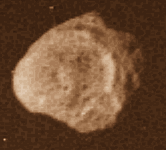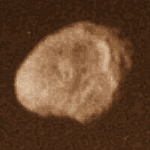
 |
orbit: 1,481,100 km from Saturn
diameter: 286 km (410 x 260 x 220)
mass: 1.77e19 kg
In Greek mythology Hyperion was a Titan, the son of Gaea
and Uranus and the father of Helios.
Discovered by Bond and Lassell in 1848.
 Hyperion is the largest highly irregular (non-spherical) body in
the solar system. Proteus is quite a bit larger
but is almost spherical.
It seems likely that Hyperion is a fragment of a larger body that was broken
by a large impact in the distant past.
Hyperion is the largest highly irregular (non-spherical) body in
the solar system. Proteus is quite a bit larger
but is almost spherical.
It seems likely that Hyperion is a fragment of a larger body that was broken
by a large impact in the distant past.
Like most of Saturn's moons, Hyperion's low density indicates that it is composed of water ice with only a small amount of rock.
But unlike most of Saturn's moons, Hyperion has a low albedo (.2 - .3) indicating that it is covered by at least a thin layer of dark material. This may be material from Phoebe (which is much darker) that got past Iapetus.
The Voyager images and subsequent ground based photometry indicate that Hyperion's rotation is chaotic, i.e. its axis of rotation wobbles so much that its orientation in space is completely unpredictable. Hyperion is the only known body in the solar system that rotates chaoticly but simulations seem to indicate that other irregular satellites may have done so in the past. Hyperion is unique in that it is very irregularly shaped, has a highly eccentric orbit, and is near another large moon (Titan). These factors combine to restrict the set of conditions under which stable rotation is possible. The 3:4 orbital resonance between Titan and Hyperion may also make chaotic rotation more likely.
Hyperion's odd rotation probably accounts for the fact that Hyperion's surface is more or less uniform, in contrast to many of Saturn's other moons which have distinctly different leading and trailing hemispheres.